Future Tense: Arts Education Technology
J. Paul Getty Center for Education in the Arts
Los Angeles, California
January 24, 1991
Transcript of Talk by Vibeke Sorensen
Session: Producing Art with Computers
I started out in college in 1971 as an architecture student. I was drawn
to the field because it combined my interests in art and science. I wanted
buildings to move, an extension of our experience of moving through them.
Architecture is an abstract experience, and I imagined abstract paintings
that would come off the canvas, fill the space around us, and in defying
gravity, dance and respond to our movements. The idea of performing complex
images in real time like a musician performs a musical instrument was not
possible until the electronics revolution. Hence, my initial interest in
electronic animation. I was interested in video for another reason. Electronic
technology and telecommunications is an "invisible" environment,
and I wanted to help bring about a more esthetic and directly human approach
to it. Television and computers are powerful and pervasive media which directly
affect out world view and our values. I sought a kind of control over this
environment in order to understand, shape, and ultimately transcend it.
I wanted to infuse alternative ideas into it so as to extend it and make
it more responsible. Finally, I wanted to see technology democratized!
(1)* Getting back to performing images, here you see me performing a patch
programmable video synthesizer in real time in 1980. It combined electronic
music technology with video special effects.
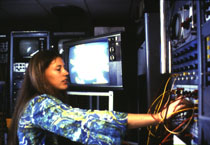
(2) A gallery installation at Virginia Polytechnic Institute in 1982 included
a microphone interfaced with a video synthesizer. The voices of the people
in the space altered images of themselves, which were displayed on the monitors
hidden in the darkness looking at them.
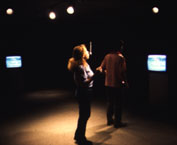
(3) I collaborated in video post-production houses wherever and whenever
I could work out an arrangement. Being non-commercial, experimental projects,
it was often difficult. In this case, Dean Winkler was an engineer who became
interested in my work, and I collaborated with him and Tom DeWitt on this
piece and others. I composed the music.
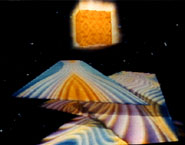
(4 - 5) In Voyage, I worked collaboratively, using footage of Jupiter
from the Voyager spacecraft. We combined it with images from a spectrum
analyzer and other electronic devices. Electronic technology extends our
senses; we can see outwards and inwards, and this piece explores this capability.
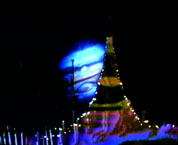
(6) I began working more deeply with digital devices in order to achieve
more control over every picture element. Unfortunately, to do this in 1983
meant giving up real-time movement. In this piece, Cool Fire, I
used a digital paint program at Caltech, and I attempted to create a sense
of motion in what is a still image. It also implies a "MacLuhan-esque"
interactive possibility inherent in the medium.
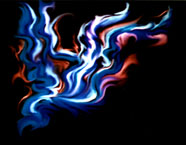
(7) In 1984, I worked on an experimental computer animated film, The
Magic Egg, shown at planetaria around the world. I chose the constellations
and the transformation of the anthropomorphic and anthropocentric view of
the cosmos to our modern view. The sphere around the earth moves into a
coincident placement on the planetarium dome whereupon the constellations
dissolve out and the stars appear at infinity instead of on the dome.
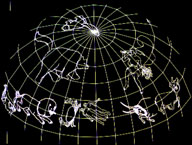
(8) The representation and transformation of knowledge and information through
symbols and language became a more conscious element in my work. Specifically,
the contemporary language of technology and with it, its potential for transforming
our perception and experience. InFish and Chips,
the fish represent the creative impulse, art, and the subconscious. The
chips, of course, represent technology.
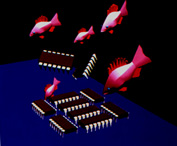
(9) This piece is called Microfishe, and
it has lots of little fish in it.
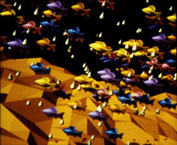
(10) This is called Parroty Bits
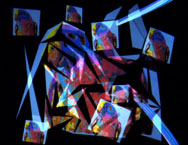
(11) The cliche, "it's not a bug, it's a feature" became It's
Not a Bug, It's a Creature
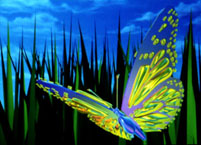
(12) In the Three Ring Circuit, I
designed and built a simple interactive sculpture which uses LED's or Light
Emitting Devices, in a plexiglas box. The parts are laid out for esthetic
rather than technical reasons, like a painting rather than an engineering
design. I feel that electronics should be part of our creative media "toolkit"
or "palette", much like any other medium. Of course, the computer
is a malleable, dynamic medium taking many forms.
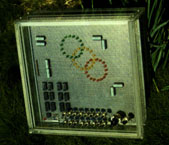
(13) Cycles refer to time, and I moved into music again. I worked on multiple
monitor installations in 1987-88 using 3 tapes and 9 monitors in live musical
performance. Each monitor is like a voice or a dancer, carefully choreographed
and edited. Here, with the Percussions of Strasbourg in Nice, France.
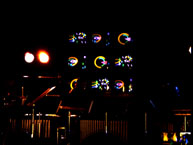
(14-20) In NLoops, "N" refers
to "Number" and "Loops" means "Loops of animation
cycles." I applied polyrhythmic musical structures to animating visual
form. Loops of animation cycles, painted by hand so as to infuse the human
gesture, were finally put into motion through the use of computer processes.
I worked with concepts of film history: the zoetrope, film, and finally
computer animation. It is a 9 monitor piece. The light emitted from the
monitors bathes the viewer in waves of light, like swimming in a pool of
rhythmic color.
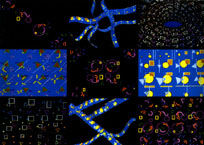
(21) In Concurrents, I worked with the
concept of parallel processing or "concurrent computation," represented
by the 9 monitors, and based the animation on the conflict between nature
and technology. I used many different techniques, including the use of a
camera as a paintbrush, to infuse human gesture into it. Music is by Gaylord
Mowrey.
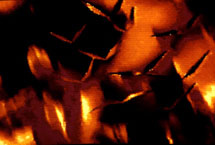
(22-30) The stereoscopic Reflection Study Series
explores perceptual paradox resulting from reflecting spaces in surfaces.
I use 3-D computer models and ray tracing techniques to create mathematically
correct but impossible spaces. I work with abstraction to focus my exploration
of perception. These images have compelled med to more deeply question how
we process visual information between our eyes and our minds. This is continuing
work.
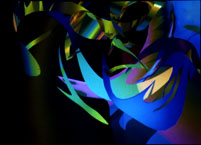
(31) At the San Diego Supercomputer Center (SDSC), I am currently working
with scientists through a National Science Foundation Grant to help shape
new "tools" and dynamic environments which will hopefully bring
us a new way of interacting with complex computer models, worlds of our
own creation, and shared worlds from afar. Finally, this brings me full
circle to the 3-D moving painting mentioned at the start of my talk. The
projection is wall sized and I can move the objects in a large scale environmental,
stereoscopic space.The piece I am working on is called Maya.
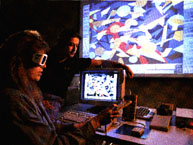
I feel that active involvement in the development of the technology is the
only way to affect its change and the media according to our imaginations.
The visions of artists push the advances, both culturally and technologically.
Artists transform themselves, their media, and their environment. They are
mirrors and catalysts, positive role models prototyping the future.
January 24, 1991
Text and images © 1980-91 Vibeke Sorensen
vsorensen@gmail.com
Go to 
Go to 
Go to 
Go to 
Go to 















